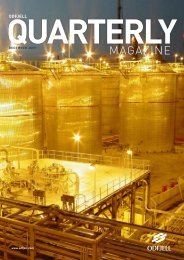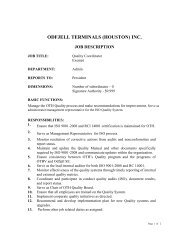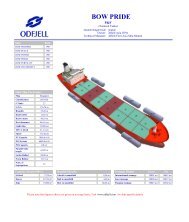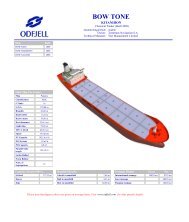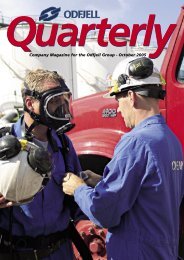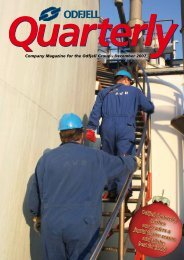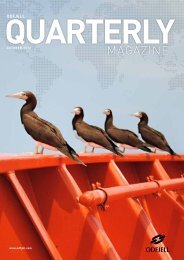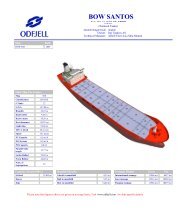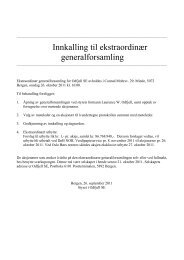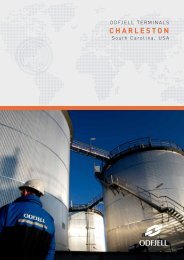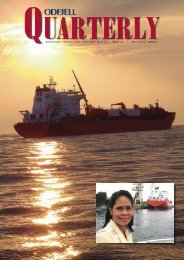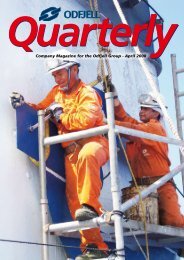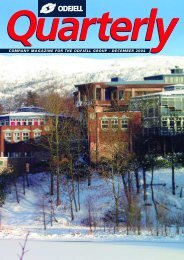Create successful ePaper yourself
Turn your PDF publications into a flip-book with our unique Google optimized e-Paper software.
In this issue:P.O. Box 6101 PostterminalenN-5892 BergenNorwayTel: +47 55 27 00 00Fax: +47 55 28 47 41E-mail: quarterly@odfjell.comInternet: www.odfjell.comEditor:Klaus WalderhaugEDITORIAL COMMITTEE:Brit A. BennettTor JürgensenSiri-Anne MjåtvedtMorten NystadHelge OlsenMarit Beate SimonsenEllen SkagenAnne-Kristine ØenCORRESPONDENTS:Rotterdam:Theo Kruithof681014The end in Poland... at least for nowPit Stop!Favourable RepairsBay 7 expansion projectin HoustonSingapore:Atle KnutsenDeadline next issue:November 5th, <strong>2007</strong>Design: MacBox ASCover:Emergency rescue operation onNCC Mekka off Los Angeles in2003. A suspected appendicitisrequired the patient to belanded by helicopter.Photo:Chief Engineer John Hadsel,now on M/T Bow SkyThe Caofeidian Project ................................................................................................... 4Naming Ceremony in Nagasaki ...................................................................................... 5<strong>Odfjell</strong> Superintendent Trainee Programme ................................................................ 16The Cheetah Rescue Posse ............................................................................................. 18Radio Medico ................................................................................................................. 19<strong>Odfjell</strong> CrewMail ............................................................................................................ 20Bow Octavia and Bow Olivia .......................................................................................... 21Bamboo rising to the sky - Expansion at OTK .............................................................. 22QM Corner........................................................................................................................ 23The Korea class goes double-hull .................................................................................. 24Safety Bulletin.................................................................................................................. 25<strong>Odfjell</strong> Locations - Buenos Aires..................................................................................... 26Aluminium dome roofs at <strong>Odfjell</strong> Terminals (Rotterdam) ........................................... 28MPA Singapore firefighters visit Bow Century ............................................................ 30Agency Performance Project........................................................................................... 31Tank Cleaning Operations .............................................................................................. 32The Subic Bay Experience................................................................................................ 34Green Flag Environmental Achievement Award........................................................... 35Greetings from around the world ................................................................................. 36The Personnel Corner ..................................................................................................... 40Brainteaser ...................................................................................................................... 41Fleet and terminals ......................................................................................................... 422 <strong>Odfjell</strong> <strong>Quarterly</strong> <strong>September</strong> <strong>2007</strong>
The A-frame is safely secured with loose pillars. Next step is to lift and remove theold crankshaftThe new crankshaft being lowered intothe bedplatethree chain-blocks were connected tothe old crankshaft with the chains passingthrough the “block,” making it possibleto lift the shaft. Once lifted, steelplates were fitted to cover the bedplatecompletely before a cradle was manoeuvredin position just underneaththe shaft into which the shaft was lowered.The cradle was then manoeuvredthrough the shell opening and removedby crane.When the new crankshaft arrived byairfreight (!) from South-Korea onJuly 19th, the old shaft was alreadyremoved. The new shaft was manoeuvredinto the engine room, lifted, cradleremoved and steel plates removedbefore the shaft could be lowered intothe bedplate, followed by lowering ofthe “block.” The operation from the“block” was lifted and lowered againtook only four days.With the new shaft safely fitted inthe bedplate, the project went from aphase where we more or less waitedfor the new shaft to arrive, to a phasewhere every hour counted: we wantedto have the vessel back in operationas soon as possible. The yard providedsome of their best people who togetherwith the engine builder’s representatives,managed to keep a high degreeof efficiency. Several service engineersfrom different companies were calledto verify the functionality of systemsand components, and with only minordelays, the engine was ready for startupon August 14th.This first start was done alongsideASRY’s berth number 1. The enginestarted on first attempt and was run for15 minutes before the bearing temperatureswere measured. These turned outok, and the engine was started again,this time it ran for 30 minutes. Onceagain temperatures were checked andthe crankshaft measured, without anydeviation from what is normal. The vesselwas ready for sea trial, which commencedon the morning of August 15th.During this sea trial, the quality of thework done became obvious. The engineran like Swiss clockwork, the timing ofthe engine proved close to perfect andthe problems we experienced were lessthan after an ordinary dry docking.Hence, we could end the sea trial earlierthan planned. Finally, on August 16that 4 am, exactly 6 months and 12 daysafter the breakdown on February 4th,M/T Bow Favour was back on hire.The new crankshaft being lifted into the hullSketch of the Bow Favour engine,looking aft<strong>Odfjell</strong> <strong>Quarterly</strong> <strong>September</strong> <strong>2007</strong> 13
Bow Octavia and Bow OliviaBy Frode StornesWe have this summertaken on timecharterthe twoUsuki-built shipsBow Octavia andBow Olivia. Ontheir maiden voyages,Bow Octaviasailed in ballast toSouth East Asia and loaded vegetableoils for Africa, and Bow Olivia loadedsulphuric acid in the Philippines forChile. Both ships are intended to tradein the Western Hemisphere, and attime of publishing, both ships shouldbe crossing the North Atlantic on theirway to Rotterdam.Their Japanese owner, Nisshin, is a privatelyowned company that started withliner services in 1967. They have grownto an owner with a fleet of approximately35 ships; mostly bulk carriers,but also product and chemical tankers.Their chemical tankers are on timecharterto MTMM, Stolt-Nielsen andAhrenkiel. Nisshin is in charge of technicaland crewing management forall their ships through their subsidiaryVictoria Ship Management, located atthe same address in Tokyo as the owner.Bow Octavia and Bow Olivia are ontime-charter to our partner Ahrenkiel,who in turn has let the ships sail in apool operated by <strong>Odfjell</strong> Seachem. BowOctavia and Bow Olivia are ships numberthree and four in a row of six sisterships from Nisshin/Ahrenkiel. The twolast ones are yet to be completed fromthe yard. <strong>Odfjell</strong>, on the other side, contributesto the pool by six similar ships,whereof four are delivered, on directtime-charter from other Japanese owners.By April 2008, all twelve ships shallbe delivered and the pool will be complete.In cooperation with the T/C-owner,<strong>Odfjell</strong> Seachem operates two wellequipped and efficient ships and wehave established a good workingrelationship with both Nisshin andAhrenkiel. The two ships have stainlesssteel cargo tanks, they have goodfresh water facilities and separate freshand sea water cleaning lines on deck aswell as good tank cleaning equipmentand fixed nitrogen generators. We wishCaptain Labuguen and Captain Pasculaand their compliments welcome onboard and we look forward to manygood years of service and cooperation.Fast facts Bow Octavia Bow OliviaDelivered: 01.06.<strong>2007</strong> 31.07.<strong>2007</strong>DWT: 19,990LOA / Beam / Draft: 146 / 23.7 / 9.7Tanks: 22Tank lining:Officers and crew:Built:Class:Flag:Owner:Manager:Stainless SteelPhilippinoUsuki Shipyard, JapanNKPhilippinesPool ShipsNisshin Shipping Co, TokyoVictoria Ship Management, Tokyo(subsidiary of the owner)deliveredBow Santos 05.11.2004Bow Rio 18.11.2005Bow Orania 29.03.2006Bow Plata 10.10.2006Bow Ophelia 28.11.2006Bow Fuji 07.12.2006Bow Octavia 01.06.<strong>2007</strong>Bow Olivia 31.07.<strong>2007</strong>Bow OctaviaBow Olivia<strong>Odfjell</strong> <strong>Quarterly</strong> <strong>September</strong> <strong>2007</strong> 21
Bamboo rising to the skyExpansion at <strong>Odfjell</strong> Terminals (Korea)By Sang Ki Lee, Maintenance Manager and Project Manager, OTKThe expansion at<strong>Odfjell</strong> Terminals(Korea) is underfull construction,and new tanks aregrowing up almostlike bambooshoots. During theperiod from end ofJune till early Augustwe had very unfavourable weatherconditions in Korea. Heavy rainfall forweeks obstructed our contractor DEC(Daewoo Engineering Company) towork with heavy machines in the mud.The rain was followed by extremelyhot temperatures, daily round 36-39˚C.During tank erection work, the steelaccumulated the solar energy to causetemperatures round 50˚C inside the halfconstructedtanks. To protect the constructionworkers against over-heatingwe implemented tropical work schedules(05:00 am - 3:00 pm) and regular“shower breaks” after 40 minutes work.In addition we rescheduled some itemsin our master plan and relocated part ofthe workforce to tasks such as concretework for buildings and pipe-racks.Despite the obstacles we have so faronly had a ten days delay of the wholeconstruction project, which should bepossible to catch up before the end ofthis year.PIT 8, with five tanksIntegrating New Pipeline Systems into the existing truckloading area with 14 racks39˚C - it’s hot but still going strong. Stainless steel roofs just infront of their tanksExtension of the office Building and new location for <strong>Odfjell</strong>Shipping on the terminal per mid October22 <strong>Odfjell</strong> <strong>Quarterly</strong> <strong>September</strong> <strong>2007</strong>
The process concept inquality managementBy Jan Didrik LorentzInput is convertedinto results by useof resources. Wedo it all the time,and in qualitymanagement wecall it a process. Bylooking upon ourwork as a networkof processes we carry out to achieveour common goals, we can get a betterunderstanding of interaction betweeninput, resources and results. In <strong>Odfjell</strong>it is a corporate quality managementrequirement that all units shall knowtheir own processes and consider howthey interact with others.Critical and vital processes shall be controlled.The work must be planned andfollow procedures, which we shall findin the Quality Management SystemDocument types in the QMS:CHC - checklistFOR - formJOB - job descriptionPRI - principlePRO - procedureREF - reference documentREG - regulation(QMS). Adequate resources must be allocated,which is a management task.The result must be checked for compliancewith expectations or specification.Possible deviations shall be correctedand improvements made to ensure futurecompliance.<strong>Odfjell</strong>’s Quality Management Systemdefines our methods to ensure thatstated objectives are achieved. It is welldocumented and easily found on ourIntranet (DocMap). Each document maybe searched by simple browsing techniques.<strong>Odfjell</strong> has chosen to also tagdocuments with process and manual. Amanual consists of documents that wenormally associate with a working field,e.g. chartering or it may be a mandatoryrequirement, e.g. Vessel ResponsePlan (VRP), ref. OPA 90.Manual types in the QMS:Corporate Management ManualBusiness units and staff manualsProcess manuals“Site” administration manualsCORPORATE QUALITYMANAGEMENT MANUALTable of ContentsDefinitionsIntroduction2006 Q2Mission and PoliciesOrganizational structuresResponsibilities2006 Q4Human Resource Management <strong>2007</strong> Q2Common DirectivesProcesses and elements ofQuality Management<strong>2007</strong> Q3Quality Management SystemQuality Assurance and Improvement 2006 Q3Event AnalysisHSE Management<strong>2007</strong> Q1Risk ManagementThis was a processDid you recognize that reading this wasa process? The magazine article was theinput and you with reading capabilityand light as well as time were resourcesallocated by yourself as manager. Didthe result meet with your expectations?Looking upon it this way may be usefulif you want to analyse why it failed orwas successful. You even have a new experienceyou may use before you starton the next article.✔QM CornerConstruction overview of the new tank pits 6, 7 and 8 with 25 tanks.<strong>Odfjell</strong> <strong>Quarterly</strong> <strong>September</strong> <strong>2007</strong> 23
The Korea class goes double-hullDry-docking and double-hull conversion of Bow PioneerBy Geirmund DrivenesM/T Bow Pioneerwas delivered fromthe shipyard in Koreain May 1982, andearly this summershe was due for herfifth class renewal.In connection withthis scheduled drydocking,we alsoplanned a conversion of four cargotanksto meet the MARPOL double-hullrequirements; cargo-tanks 1 and 12, SB& P. The principle of the conversion isto introduce a longitudinal bulkhead inthe tank with a minimum distance fromthe ship side of 760 mm. By doing theconversion, the ship would no longer besubject to IMO’s single-hull phase outrules and would be allowed to load easygrade Annex I cargoes.The conversion engineering was carriedout by Bergen-based SkipskonsulentAS, in cooperation with <strong>Odfjell</strong>’ssuperintendent and Det Norske Veritas.The main challenge was to locatethe longitudinal bulkhead efficiently,minimising added steel weight, retainingsufficient strength and at the sametime avoid “stealing” too much volumefrom the cargo tanks. The chosen solutioncomprises these three challengesby situating the longitudinal bulkheadat no place closer than 1,000 mm fromthe ship side with a total weight addedof approximately 110 tonnes and witha total “lost” cargovolume of about800 cbm. The newspaces in the ship’sside are dry voidspaces, planned forneither cargo norballast.COSCO Nantongshipyard hasthrough the lastcouple of years carriedout doublehullconversionsof many ships andfor many owners,to help them avoidtrading restrictionscaused by IMO’ssingle-hull phase out rules. For <strong>Odfjell</strong>all five KSEC class ships were convertedfrom April until December 2006 withsuccessful results.Bow Pioneer arrived at COSCO Nantongon June 11th and the entire projectincluding dry-docking and repairs,class renewal and the conversion wascompleted by August 12. The projectwas initially planned completed muchquicker, however, due to an extremelyhot summer in China, governmentalrestrictions imposed a complete stopin the activities at the yard as soon astemperature exceeded 36 degrees Celsius.This caused a lot of time during theThe access hole that was cut in the deck to insert the steelpanels for the longitudinal bulkhead in cargo-tank 12 SBnormally busiest part of the day to passby without any real progress.In addition to the conversion, the shipshad its CAP rating renewed at level 2,by replacing approximately 35 tonnesof steel. Other steel jobs of significancewere the replacement of parts of thefore and aft stainless steel bulkheadin cargo tank 6C, to repair damagesdone during cargo operations last winter.Other main items on the repair listwere cleaning/sweeping and paintingof the ship’s side and bottom, a majoroverhaul of the main engine, significantrepairs and overhaul of the FRAMOcargo pumping system, boiler repairs,recoating of cargo tanks, in particularsthose subject to conversion, in additionto minor coating repairs in a few of theballast tanks.The newly painted Bow Pioneer in dry-dockThe four sister ships sailing in a pool,Bow Pioneer, Bow Hunter, NCC Arar andNCC Asir, will all go through the sameconversion. The NCC ships have recentlyfollowed and the conversion projectwill be completed by Bow Hunter, whois planned to arrive at the repair yard inNantong by mid October. The superintendentfor the Bow Pioneer conversion,Ole Abrahamsen, will also supervise themodification of Bow Hunter and thus,he will be well prepared for the challengesthat meet him when Bow Huntercalls Nantong for her repairs and conversion.24 <strong>Odfjell</strong> <strong>Quarterly</strong> <strong>September</strong> <strong>2007</strong>
By Toralf SørenesEnclosed SpacesEnclosed spaces have two main risk factors;lack of oxygen, and presence offlammable gases that again can lead topersonal injuries or fatalities and fire orexplosions. Since our last Safety Bulletinboth scenarios have unfortunately materializedon ships used by <strong>Odfjell</strong>.Safety BulletinIn the November 2006 Safety Bulletinwe wrote about the dangers of N 2 inenclosed spaces. For our operations thisis mainly cargo tanks. Our 2006 articlewas triggered by a senior officer thatlost his life because he entered a tankthat was N 2 inerted. The ship was neitherowned nor managed by <strong>Odfjell</strong>,but she was commercially operated by<strong>Odfjell</strong> Seachem (OS). In August thisyear we had a very similar accident: asenior officer entered a tank that wasN 2 inerted and lost his life. Again, theship was commercially operated by OS,but neither owned nor managed by<strong>Odfjell</strong>. Other common denominatorswere, however, also noted. Both the deceasedwere experienced senior officersand, amongst other duties, in charge ofissuing tank entry permissions. Neitherof them used personal gas meters andboth were obviously JUST going intothe tank to fix/fetch or check something.By-standing crew did not intervene,possibly because a senior officerwas involved. We have said it manytimes before and will continue to repeatthe message, never by-pass or short-cutprocedures and checklists in this area. Atypical example is that something is lostor gets entangled on the first ladderplatform and one just enters becauseit is so close, both in distance and timeneeded.N 2 is very dangerous because of oxygendepletion in combination with anShip Security & PerformanceAt Risk Management we are presentlyin the process of updating our Ship SecurityPlan (SSP). This is a yearly processthat follows the annual review of theSSP made by the ships. We hope to completethis updating by mid October andwill take this opportunity to thank theships for valuable inputs. These structuredinputs from those out there in thefield will greatly assist us in making theanaesthetic effect. If exposed to it, onewill normally not fully understand whathappens and therefore not be able toact in a rational manner. In both casesthe officer who entered the tank encounteredproblems very quickly, lostconsciousness and fell to a platform. Theassisting crew raised alarm, evacuationwas initiated and the person broughtup on deck and first aid including administrationof oxygen was given. Thisoperation was done very quickly by welltrained crew, but unfortunately it wastoo late to save the persons life. Theabove examples are sad and show thattank entry procedures are not somethingto play around with. You may endup not getting a second chance andthere is no difference between ranksand seniority.The other accident involved hot work ina tank during a stay at a repair yard. Theship was owned and managed by <strong>Odfjell</strong>and had been at the yard for sometime when the accident occurred. Gasfree certificates had been issued bothfor the complete ship during pre-arrivalchecking and later on daily basis priorSSP slimmer, more user-friendly, and lastbut not least, a good and active instrumentfor making our ships and operationssafe and secure.In February 2006 we distributed ourfirst performance report at Ship Managementdepartment (SMD). These reportsare closely connected to our KPIs.They are distributed on quarterly basisto commencement of work. At normalday hours a small fire occurred ina tank. No damage of any significancewas noted, but a safety team from theyard attended to investigate. Shortlyafter their arrival on the site, a secondand stronger fire occurred and a personfrom the attending team was seriouslyburned and later passed away. The lessonlearned is that a chemical tanker iscomplex both with regard to constructionand cargoes, and a gas free certificateis only a piece of paper. Thereis always a possibility that flammablecargoes could be trapped somewherein blind ends on lines, low points, drainchocksor that oxygen/gas can leakfrom equipment used by the yard. In anenclosed space this may result in flammablegases/mixtures accumulatinginto a level that is dangerous. It is thereforevery important to maintain safetyawareness throughout the dry-dockingand to measure gas levels on a regularbasis. Smaller fires or “puffing” say thatsomething is wrong and all work mustbe stopped until the causes have beenfound and eliminated.and have continuously been expandedand improved. A few issues will, however,still need further refinement. Thereport is an important instrument ingetting a picture of where SMD standon important issues. This will help us toidentify areas that need particular focusand later to see if this focus has had thedesired effect.<strong>Odfjell</strong> <strong>Quarterly</strong> <strong>September</strong> <strong>2007</strong> 25
<strong>Odfjell</strong> LocationsThe city of the good windsBuenos AiresBy Horacio MarquezThe name BuenosAires could betranslated to either“Good winds”or “Good Airs”. Itwas the first meaningwhat possiblyprompted Don Pedrode Mendoza,on that humid andsuffocating summer day in 1536, tochristen the small wooden fort he hadbuilt on the shores of the Rio de La Platawith the name “Santa Maria de losBuenos Aires”.After a fairly short period of living togetherin peace, the natives realizedthat the newcomers’ ideas for their jointfuture were not going to benefit themmuch, so they set fire to the small village.There only remained a few horsesand cows that had been brought fromEurope, which, as is common practiceof most free live beings, happily devotedthemselves to reproducing forthe next forty years. But the “party”ended when a second Spanish expeditionarrived, this time lead by Don Juande Garay, who re-founded Buenos Aireson June 11th, 1580. This free-grazing“craze”, combined with genetic improvementsintroduced by the Britishin the nineteenth century, set the basesPlaza de Mayo (May Square) with el Cabildo, the old town hall26 <strong>Odfjell</strong> <strong>Quarterly</strong> <strong>September</strong> <strong>2007</strong>for the now-famous live stock industryin Argentina.Having been a Spanish colony for overtwo hundred years and resisting twonon-requested invitations by the BritishNavy to become eternal devotees ofthe Five o’clock tea, the inhabitants ofthe port city (thus receiving their name“porteños”) achieved independence onMay 25th, 1810. They spent the nexthalf a century fighting each other todecide on a proper form of government.Always succeeding at making thesimple more complicated, they foundedthe Argentine Nation in 1862 under afederal model, which of course, was alwayscentralized at its main port city.From this feature rises the popular saying“God is Argentine but has his officein Buenos Aires…”During its first eighty years of independence,the white skinned citizens turnedtheir backs on their inland brothers anddark-skinned neighbours, always takingEurope as a reference model thatwould define their character. The BritishEmpire provided the city with capital,railroads and an economic model;France showed the way of enlightenmentin terms of intellectual thoughtand also frivolous fashion; but it wasItaly, with its illiterate masses arrivingCalle Caminito (Caminito Street) inLa Bocain the beginning of the twentieth centuryas they fled hunger and hopelessness,that left the deepest impact on thecity’s soul and customs. Together withthe Italians, millions of immigrants fromall over Europe worked endless hours tohelp build the “world’s granary”, thesuccessful agro-exporting model thatwould secure Argentina’s wealth untilWorld War II. Since then, the “AmericanWay of Life” has changed many things,but Buenos Aires continues to proudlyexhibit its European roots like no othercity in Latin America.So, what is the modern city like? Anurban conglomerate of three millioninhabitants that rises to eleven millionwhen the suburbs are included; wheredifferent architectural styles coexist depictingreplicas of Europe at each cornerof downtown: Plaza de Mayo and SanTelmo embracing the colonial spirit, LaBoca, where the Genoese founders builttheir modest houses painted in brightcolours, Puerto Madero unmistakablyreferencing the London Docklands, theAvenida de Mayo portraying a flair ofMadrid, Recoleta with its French styleand finally the broad Parisian-style boulevardsthat lead to the Palermo gardens- a gigantic green space built towardsthe end of the nineteenth century replicatingNew York’s Central Park. Today,
Puente de la mujer in Puerto Maderothe gardens are a Mecca for outdoorsactivities such as bicycling, sunbathing,rowing and jogging and often a spot for“sin” at night. A much less sinful but excitinglyupbeat panorama can be foundin bars, restaurants and dancing clubs invarious nightspots such as Palermo, LasCañitas, San Telmo or Puerto Madero.As in the rest of Latin America, incomedistribution inequalities and the introductionof hard drugs have produceda violent society whose only way out isthrough the eradication of these twocauses. The economic crisis of 2001,the most dramatic of Argentina’s history,worsened the situation and duringthis period unemployed picket linesflourished everywhere giving way to avery socially unkind way of denouncingproblems: street and route cuts, a muchtoo common landscape in today’s downtown.Even if the economic indexes areback to the levels they were at beforethe crisis, the scars it left on the socialfabric are truly deep and it will take agreat deal of work and development toheal them.Argentines value skill over strength,freedom over order and individualismover organization; nevertheless theycan only conceive the sweetness of victoryas a result of team work, that is whythe national preference is ball gamesrather than individual athletic practices.Soccer is the king of sports and matchesbetween the two biggest and oldestteams, Boca Juniors and River Plate, arean integral part of any tourist packagesold abroad.At dusk, La Reina del Plata (The Queenof the River Plate) dresses for successturning on its millions of lights to offera wide variety of entertainment optionsincluding late night dining, nightclubs,art exhibits, and over one hundred cinemasand theatres. The city’s vast culturaloffer includes the renowned Teatro Colon,a majestic opera house built in thelate nineteenth century, the InternationalDance and Theatre Festival showcasingprestigious local and foreigncompanies, and over a dozen museumsfeaturing various art collections.Towards 9 pm, restaurants get busy offeringethnic food from all corners ofthe world at every price point, but localcuisine remains the favourite with itswide array of dishes featuring “the bestmeat in the world” and world-famousMalbec wine. Pizza, pasta and beercomplete the menu reminding us of theItalian heritage. Late at night, His Highnessthe Tango shows up to unveil a delightfulcombination of emotion, musicand movement attracting both foreignersand locals to the dance-floor.When you add to all of the above a muchcirculated rumour about the beauty andsensuality of Argentine women, is it anywonder that airplanes full of visitorssimply cannot stop arriving in BuenosAires?The obelisk on the Avenida 9 de JulioPalermo Chico, stainless steel flower sculptureMeat Argentine style<strong>Odfjell</strong> <strong>Quarterly</strong> <strong>September</strong> <strong>2007</strong> 27
Aluminium dome roofs at <strong>Odfjell</strong>Terminals (Rotterdam)By Gert van Meijeren, Managing Director, CTS BV<strong>Odfjell</strong> Terminals (Rotterdam) (OTR),like other tank owners, is constantlylooking for methods to comply withthe increasingly demanding legislationand to safely and effectively operatetheir tanks. To achieve this, OTR hasequipped three new methanol tankswith aluminium domes and aluminiumfull contact internal floating roofs. Alreadymore than a decade ago OTR putaluminium dome roof on seven tanksfor storing water-sensitive productssuch as methanol, ethanol and MTBE,but these domes were built on top ofexisting tanks.This combination of aluminium domesand internal floating roof offers significantadvantages compared to moretraditional steel external floating roofsor fixed steel roofs covering an internalfloating roof:• Low maintenance costs, due to thematerials not requiring any maintenancesuch as blasting or painting duringtheir entire service life.• Lower emissions. The combinationof an aluminium dome and full contactinternal floating roof will drastically reducethe tank emissions compared to anordinary tank.• Eliminate weather influences. Coveringthe tanks completely eliminates theinfluence of wind, rain and lightning.• High reliability. As aluminium domesrequire no maintenance and an internalfloating roof configuration has no drainline configuration, this tank design ismuch more reliable than other availableatmospheric storage tank designs.• Stores a wide range of products.The range of products is extended with(bio-)fuel related products such as alcohols,ETBE and MTBE. Anodised aluminiumfor the internal floating roofsguarantees product compatibility for avery wide range of products.Tank emissionsReducing emissions of volatile organiccarbons is of great importance for moderntank terminals, and OTR is committedto realising a maximum emissionreduction for all tanks operated, particularlynew tanks. We have calculatedemissions comparing the supplied domeand full contact aluminium internalfloating roof with liquid mounted shoeplate seal and secondary seal against astandard steel fixed roof tank with nofurther emission reduction measures,based on 12 turnovers of methanolper year. The emissions from an internalfloating roof tank were calculatedto 301 kg per year compared to 40,453kg per year for the standard tank, areduction of some 99.3 %. Under IPPCBAT requirements, reducing emissionssignificantly beyond initial reductionsis increasingly important and thus, usingdomes with internal floating roofs isclassified as Best Available Technology.Building the domes and internalfloating roofsThe domes have been built inside thetank by a joint efforts of tank constructorMercon and CTS. The domes wereConstructing the dome frame inside thetankcompleted in less than four weeks andlifted on the tanks with a 400 tonnesmobile crane. The flight of the lift (over40 metres from crane centre to theThe structure is completed, and the first panels are installed28 <strong>Odfjell</strong> <strong>Quarterly</strong> <strong>September</strong> <strong>2007</strong>
Agency Performance ProjectBy Tore VaageneTransportation ofchemicals at searequires, in additionto high qualityships, good operationalproceduresand skilled crew,also first-class portagents.Over the years we have seen that inan increasing number of port calls, theservices provided by our agents are notat an adequate level for meeting ourfuture demands as to back office structure,port agency ICT structure as wellas port agency finance structure. Manyagents perform their duties based ontradition and in accordance with whatthey regard as their long-term experience.There is no doubt that, in a traditionof trust and good working relationship,the service level provided by manyagents has not been questioned or challengedproperly.Today our “List of Agents” covers approximate690 different ports in morethan 100 countries. Our network of portagents consists of a mixture of small independentagencies and some of theworld’s largest marine service providers,e.g. Inchcape Shipping Services and BarwilUnitor. In 2006, <strong>Odfjell</strong> Seachem and<strong>Odfjell</strong> Asia together recorded nearly3,700 port calls in 490 different portsworldwide. Average number of berthsper port call is approximate 2.5, givingnot less than 9,250 berth calls per year.The purpose of the Agency PerformanceProject, which started in July <strong>2007</strong> andis expected to last for 1-2 years, is toensure that <strong>Odfjell</strong> Seachem developsthe best and most cost efficient agencystructure. Combined with other efforts,the project will contribute to improve<strong>Odfjell</strong> Seachem’s operational performance,which in turn will reduce time inport, improve customer satisfaction andincrease profitability. The project teamincludes members from Bergen, Singaporeand Rotterdam.The first phase of the project waslaunched some weeks ago when wesent an information letter to all our portagents, to establish an “as-is” overviewof our current port agency structure.So far we have issued four differentsurveys, to gather information from the<strong>Odfjell</strong> organization on how our currentagency network is performing. Thishas provided valuable information andfeedback from our captains, ship operators,D/A desk, marine accountants anddemurrage desk. The surveys measure,amongst others:• Adherence to the <strong>Odfjell</strong> SeachemAgency Instruction• The physical presence of the agent in port• Are all documents/vouchers presentedin a correct manner?• Correct tendering of NOR• Availability during and after office hours• Level of service and pro-activeness• Communication• Pre-arrival information• Port stay service• Problem solvingVessel in portThe second phase of the project will beto identify and define <strong>Odfjell</strong> Seachem’sfuture requirements as to port agencyback office capacity, ICT structure as wellas finance structure, and to find optimalsolutions for port service agreements.During this fall we will invite severalpotential service providers to Bergen topresent their organisation and capabilities.Based on the findings of the surveys,we will make our conclusions andbenchmark our findings against <strong>Odfjell</strong>Seachem’s expectations and demandson our future service providers.<strong>Odfjell</strong> <strong>Quarterly</strong> <strong>September</strong> <strong>2007</strong> 31
What they actually doTank Cleaning OperationsBy Torger Trige, Cargo Handling AdvisorTank cleaning is oneof the jobs that arecarried out very frequentlyon boardchemical tankers,as such ships alwayshave to presentload-readytanks, completelyvisually clean, dryand odourless, before loading. This isnormally referred to as a water whitestandard cargo tank, and is regardedas a minimum requirement for loadingchemicals. In case of delicate high puritychemicals, such as potable ethanol ormethanol, tank cleaning will continuebeyond water white standard, in orderto be prepared for wall wash testing.Wall wash with subsequent analysis ofthe samples in a laboratory is an establishedway in our industry to determinethe cleanliness and thereby the suitabilityof a cargo tank for carriage of delicatecargoes. A wall wash sample is collectedby running a certain amount ofpure solvent down the bulkheads insidethe cargo tank. The test criteria variesdepending on the cargo to be loaded,but commonly they aim at detectinghydrocarbons, chlorides, colour, smellor specific cargo residues in the sample.Our ships are normally equipped withbasic laboratory equipment, to enableChief Officer Legada and Bosun Abellen preparing for spraying a tank withdeionised waterthe crew to check the tanks’ suitabilitybefore presenting them for surveyor inspectionin the load ports.In general terms, a cleaning operationnormally consists of cleaning with waterat suitable temperatures accordingto last cargo properties. If needed it isfollowed by cleaning with detergentsand another round of water cleaning.Ventilation, fresh water rinse and dryingare also carried out as necessary, andyou keep on repeating the routine untilachieving the desired result. The trickypart is to find the appropriate watertemperatures, the correct type and dosageof cleaning compound, the optimallength of time for machine cleaning,determine the necessary use of manualwork and last but not least, assess thesafety of the operation. Cargo properties,such as water solubility, solubilityin cleaning chemicals or solvents, meltingpoint, drying properties (vegetableoil), viscosity, sediment problems, toxicdangers, flammability and coating restrictions,are vital decision factors consideredto be basic knowledge to eachand everyone involved with cargo operations.By and by this is worked intothe bone of people on board, makingthem able to make the correct decisionson a cleaning procedure.Bow Puma at anchorage waiting to berth in SantosTank cleaning is a critical operation asdefined by the <strong>Odfjell</strong> Shipboard ManagementManual. This manual prescribesthe use of established sound routines,several check lists, written plans andpre-meetings before any cleaning operationcan commence. However, there32 <strong>Odfjell</strong> <strong>Quarterly</strong> <strong>September</strong> <strong>2007</strong>
Wall wash equipment inside the tankis no secret that the most important factorwhen it comes to safety in any shipboardoperation is skilled people withthorough understanding of the jobas well as the dangers involved. Thereis absolutely no substitute for real lifeexperience when it comes to practicalchemical tanker operation.Tank cleaning machines are used whencleaning a ship’s cargo tanks. They areeither lowered into the tank, typicallyon older vessels, or they are mountedfixed into the tanks. The machines aresupplied with water through rubberhoses from a pipeline on deck, normallyreferred to as the Butterworth line. Thetemperature of the water is regulatedvia a steam heater. There are a numberof other aspects in a cleaning operationthat may be necessary, such as manualcleaning, spraying with deionised waterand steaming, which require the use ofother types of equipment. However, letus not take it too far in this article.In certain cases, where the cleaning isexpected to become very demandingor needs particular procedures, MarineSupport Group can be present on boardto support the crew in carrying out theoperation. Recently I had the pleasureof joining Captain Etrata and his crewon Bow Puma, to assist in a demandingtank preparation before loading full2nd Officer Richie Mejares performing some sample testingcargo of ethanol in Brazil. Previous cargoeswere a combination of lubricatingoils, palm oils, synthetic paraffin andpropyl alcohol. All of the vessels tanksexcept the ones last containing propylalcohol were due for a severe cleaning.As mentioned the test criteria may varydepending on the quality of the nextcargo. In our case the passing of the socalledTyndall test and chloride test wasmandatory for all the ethanol grades. Inaddition, the tanks scheduled to holdhigh grade ethanol were tested withUV-test and non-volatile matter test.For the very first time we had a UV-meteron board for trial and thus, we wereable to do the UV-scan prior to presentingthe tanks.The wall washes we collected after theinitial water cleaning left us with nothingbut disappointment. The cleaningwas continued as a round the clock activity.Depending on the tasks at handwe sometimes worked long days withthe whole deck crew, but in most caseswe split the deck crew into two groupsand continued 24 hours a day in a sixhours on/off system. The engine crewwas also working around the clock in asimilar pattern while the cleaning wasgoing on, due to the massive powerconsumption and the constant use ofsteam.After 16 days of cleaning we arrived inSantos with all 27 ethanol tanks readyfor inspection. The inspection, wallwash collection and subsequent analysistook several hours and involved anotherround of procedures, check lists andpre-briefings before doing the actualjob. All the tanks passed and the loadingwent on without any problems. Welldone Bow Puma!Wall wash samples seriously failingthe Tyndall testCleaning chemicals stored on deck<strong>Odfjell</strong> <strong>Quarterly</strong> <strong>September</strong> <strong>2007</strong> 33
<strong>Odfjell</strong> maritime personnel recently revised the manning procedures and policies to meet thehighest level within oil companies’ recommended tanker managers and self assessment (TMSA).One of the requirements for reaching this level is to allow officers to attend shore-based assignments.2nd Officer Dag Aksland was offered to serve his assignment at the <strong>Odfjell</strong> Academy.The Subic Bay ExperienceBy Dag Aksland<strong>Odfjell</strong>’s Health, Safety and EnvironmentProgramme proclaims no personnelinjuries, no pollution, no damageto property nor cargo, professionalismat all levels, and open and honest communication.These ambitions require allseafarers to carefully follow companypolicies, procedures and checklists, asdescribed in the Shipboard ManagementManual. To improve seafaringskills and further enhance our precautionaryattitude, all seafarers need tobe encouraged and get more trainingin the various jobs we are performingon board.<strong>Odfjell</strong> Academy in the Philippines isdeveloping and providing courses forour seafarers, related to the company’spolicy, procedures and checklists. So farmainly Filipino seafarers have takencourses at the Academy, but shortly alsoWest European mariners will attend.<strong>Odfjell</strong> Academy<strong>Odfjell</strong> Academy is located in Subic Bay,in a very quiet and peaceful location.Wärtsilä Land & Sea Academy, the Finnishtraining centre for seafarers, is alsoon the same site, and there is a closeco-operation between these two academies.<strong>Odfjell</strong> Academy offers modern trainingquarters compared to many course facilitiesin Europe. Inside there are threeThe new <strong>Odfjell</strong> Academy buildingclassrooms, one computer-based trainingroom, offices, conference room, visitorroom and rest rooms. The classroomsare well ventilated, and the Academy iswell equipped with computers, laptops,projectors and other necessary equipmentto perform good training. Lunchis served at the Wärtsilä cantina, whichis one of the best restaurants in SubicBay, and during breaks some snacks andsomething to drink is served.During training there is an atmosphereof good harmony and sense of humour.The instructors have developed interestingcourses based on various pedagogicmethods. They will shortly unmask participantswho think they can just relaxhere, and clever questions from theundergraduates will be responded appropriately.All courses are followed byassessment tests.Outside the building a big unit with twocargo tanks are under development.These tanks will contain hydraulic-poweredFramo cargo pumps. All course participantswill soon have an actual Framotraining here. The pumps will be operatedfrom deck, and the participants cansee how the pump is working throughwindows on the tanks bulkhead. Soonthe Academy will also have a cargo controlroom with almost the same outfit asthe ones found on board.Some of the personnel at <strong>Odfjell</strong> Academy. Dag Aksland (with hat)in the middleNew regulation requires all our ships toinstall a “white box” to their engine oilywater separation system, to record theamount and quality of discharged enginebilge water into the sea. Marine-Floc AB of Sweden is delivering this sys-34 <strong>Odfjell</strong> <strong>Quarterly</strong> <strong>September</strong> <strong>2007</strong>
During gas measurement instructiontem to the <strong>Odfjell</strong> fleet, and they willalso deliver Oily Water Separator (OWS)systems to some of the vessels. All thecompany’s engine crew must be trainedin the use of these systems, and thereforeMarineFloc has delivered an OWSsystem simulator that is now used fortraining at the Academy. There are alsocourses in advanced bridge and enginesimulators, held at nearby Wärtsilä Land& Sea Academy.Subic BayIt takes about three hours to drive fromManila to Subic Bay. West Europeancourse participants will live at a highstandard hotel inside the Subic Bay MetropolitanAuthority (SBMA) area, wherealso the <strong>Odfjell</strong> Academy is located.This is a safe and restricted area, withdisciplined traffic regulations and littlecrime. Olongapo City is within walkingdistance from the hotel.West European seafarers will really enjoystaying here and feel safe. Subic Bayand Olongapo City offer a lot of entertainment,activities and restaurants& bars. The hotel is close to the beachwhere you can swim, buy souvenirs,rent a jet-sky and do other sea activities.To see the “wild” tigers and to feed thecrocodiles at Subic Safari Zoo was realfun. Ocean Adventure offers some goodshows with their dolphins, whales andsea lions. Don’t hesitate to ask the personnelat <strong>Odfjell</strong> Academy for furtheradvice. A nice stay in the Philippines willgo fast, and upon leaving Subic Bay youwill certainly look forward to comingback.Green Flag EnvironmentalAchievement AwardBy Otto Vollan, Master M/T Bow FortuneUp to date M/T Bow Fortune and M/TBow Pride have been the only two <strong>Odfjell</strong>ships receiving the Green Flag EnvironmentalAchievement Award fromthe port of Long Beach. With this we,Captain and crew on Bow Fortune,found it real easy to call at Los Angelesthis trip. Prior to arrival we hoisted the“Green Flag”, and for sure, this was thefirst thing the representative for Stateof California Department of Fish andGame recognized when attending thevessel. We received a lot of praise, andit is always nice to feel welcome. Andwho knows, maybe we are candidatesfor an “award” next year as well?Flying the Green Flag off Long BeachVessels that dock at the Port ofLong Beach will earn a GreenFlag environmental achievementaward when they attain 100%compliance with the voluntaryvessel speed reduction programfor a 12-month period (measurementbeginning in January2005). Carriers, as listed in Lloydsregister, which achieve a 90%compliance rate in a 12-monthperiod (measurement beginningin January 2006), will be eligiblefor a 15% reduced dockage rate(Green Rate) in the followingyear. This program will continuefor two years.<strong>Odfjell</strong> <strong>Quarterly</strong> <strong>September</strong> <strong>2007</strong> 35
Bunkering off LibyaBy Helge Aslaksen, Captain M/T Bow SpringBow Spring was scheduled for bunkeringwhen passing eastbound throughSuez Canal in August, but it turned outthat the local suppliers were not ableto deliver the 450 tonnes of heavy fueloil that we needed. Our voyage programmeindicated that there wouldbe slim chances to refuel before reachingFujairah, and the bunker level onboard would hardly take us that far. Theoperator and the Bunker departmentin Bergen needed to find an alternativesolution.The operator suggested a fairly newbunker-service, Nour Libya Marine ServicesCo, which offers bunkering offshorewith a well maintained supply vessel“Nour 1”. We agreed a rendezvous pointoff Libya, more or less along our coursefrom Tunisia to Suez, so no deviation wasnecessary. On August 7th at 02:15 localtime, Bow Spring met with Nour 1, andabout two hours later the coaster was allmade fast at our starboard side. Bunkeringof 450 tonnes was completed in lessthan three hours, and paperwork wentwithout problem. We resumed sea passageat 10:45, and arrived in Port Saidwell in time to transit the same night.M/T Nour 1 alongside M/T Bow SpringAlthough we have carried out a lot ofboard-to-board operations in port, thiswas the first time for us to do bunkeringin open sea while both vessels weredrifting. A bunker sample was deliveredto our agent in Port Said the next morning,and DNV analysis showed that thefuel quality was good. We may suggestdoing the same on a later occasion.FR Waring function on boardBow SummerBy Sayed Akimu PhiriFR Waring, our esteemed South Africancustomer, had some grades on board fordischarge in Durban when Bow Summerin June/July made her very first voyageto South Africa. To mark this event, theykindly requested via <strong>Odfjell</strong> Durban tohold a function for some of their clientson board this state-of-the-art vessel.Captain P.A. Nordqvist welcomed theidea, and the event was scheduled forFriday July 6th at the berth Island View4. Arrangements were made for about50 guests, and we received permitsfrom Dock Security to allow all our prestigiousvisitors on board. Finger lunch,snacks and soft drinks were served onthe spacious bridge, and with the assistanceof the Captain and his crew thefunction was such a success.the guests on a small tour of the vessel,including the cargo control room andthe engine room. All clients were veryimpressed with the vessel, and I trusteverybody enjoyed their day on boardBow SummerAfter lunch, Captain Nordqvist, theChief Officer and Chief Engineer tookOn the Bridge. From left Sundren Rajah (FR Waring), Capt. Mel Pinks (<strong>Odfjell</strong>Durban), Shaun Maitri (FR Waring), Jaya Chetty (<strong>Odfjell</strong> Durban)36 <strong>Odfjell</strong> <strong>Quarterly</strong> <strong>September</strong> <strong>2007</strong>
<strong>Odfjell</strong> Makana sends team toNorway CupBy Mel PinksAt the March <strong>2007</strong> <strong>Odfjell</strong> Makana S.ABoard meeting in Bergen, the Boardcame up with an idea that complimented<strong>Odfjell</strong> Makana’s extensive socialupliftment plan: to send a footballteam from South Africa to take part inthe <strong>2007</strong> Norway Cup in Oslo. Researchwas carried out upon costs, logisticsand indeed the choice of a team itself.Chairman of <strong>Odfjell</strong> Makana, Mr Peter-Paul Ngwenya selected a school fromone of the poorer areas of the KwaZulu midlands, Emtshezi High Schoolin Estcourt, from which a team was selectedto compete in the 18 - 19 year-oldclass.With the assistance of Tracie Robertsonand Sayed Phiri from <strong>Odfjell</strong> Durban andAneesa Iserbelas at the Makana officein Johannesburg, we managed to equipand make travel arrangements for theteam of 15 players plus the entourageof teachers and their team coach. Notleast to get passports for everybodyturned out quite a challenge. The teamkept training, also during school winterholidays, to be well prepared for thetournament.Early afternoon on Friday July 27th wearrived in Oslo, and were met by theNorway Cup organisers. The trip andnot least the flight was a completelynew experience for many of our youngplayers. As we had arrived ahead ofSolid defenceThe <strong>Odfjell</strong> Makana Teamthe competition start date, the followingday we took the team to TusenfrydAmusement Park, where we all had avery enjoyable day.The morning of 29th July we played ourfirst game, against a local Norwegianside. Although exhibiting the betterball skills, our players were considerablysmaller than their opponents andwe lost by 2 - 1. We also lost our secondgame, now by 4 - 0, which meant thatwe had to win the final match of ourgroup to qualify for the ‘B’ play-offs. Onthe day of this match nerves were tensefor all of us, especially for the teamwho knew they had to win. This timethough, the tables had turned and withsuperb shows of African ball skills wewon the match 9 - 1. Thereby we werequalified for the B play - offs. The firstplay-off match was another very tensegame, where we won by a golden goalin extra time. Unfortunately, the secondmatch resulted in a narrow loss, and wewere out of Norway Cup for this time.Nevertheless, this was really not a questionof winning or losing, although theformer would have been nice, but oftaking part. To give a group of teenagersfrom South Africa an opportunity tosee beyond the Drakensberg Mountainsand perhaps have an experience thatmay ultimately affect their lives if nottheir outlook. Among the fondest ofour memories are of the people of Oslowhom welcomed our team in such a remarkablypleasant and sociable manner.Well, perhaps the team will rememberthe Norway Cup disco just as well… Wehope we can be back in Oslo next yearto take part in this excellent event.<strong>Odfjell</strong> <strong>Quarterly</strong> <strong>September</strong> <strong>2007</strong> 37
Photographer visiting Bow Summerand <strong>Odfjell</strong> Terminals (Rotterdam)By Anne-Kristine ØenThe German photographer ThomasKohnle recently visited the Bow Summerin Rotterdam to shoot photos for <strong>Odfjell</strong>’sannual report and general photoarchive. In addition to his art photographyMr. Kohnle has a long track recordof industrial photographing, and is welladept to the challenges of this kind ofwork.A lot of precautions must be taken tomake sure that all operations are safeand that he does not interfere toomuch with the work on board whiledocumenting it. The Bow Summer, withCaptain Pierre Nordquist and Chief OfficerAnders Penna, gave Thomas a warmwelcome and made sure that everythingwas accommodated to make his workefficient. At the tank terminal TheoKruithof was responsible for the securityand work conditions, and also hereeverything was very well organised.So a big thank you to all involved, andwe look forward to showing you thefruits of the work in future publications.Thomas Kohnle at work on boardBow SummerIronmanBy Tommy Horiuchi, IBC Corporation, TokyoISC Corporation acts as co-brokers forBow Fuji, as well as assisting with arrangementsfor Santoku Senpaku’sfleet, including Bow Santos and BowLima, as V. Ships’ representatives in Japan.Recently I participated in the <strong>2007</strong>Aviva Ironman Triathlon in Singapore,for which <strong>Odfjell</strong> sponsored my triathlonsuit.I had allowed myself a total of six hoursto complete the race; 40 minutes for the2 km swim, three hours for the 90 kmbike ride and two hours for the 21 kmrun, plus a transition time allowance of20 minutes. For me, the swimming legturned out the most difficult stage, dueto very low visibility, big swell and strongcurrents. Usually, triathletes don’t usetheir legs very much while swimming,but because of the conditions I had tokick more than normal and suffered legcramps as a result. The bike leg is usuallymy weakest stage, but fortunately theSingapore course was very flat and fast.Most parts of the running course wereshaded by trees and luckily the weatherwas not hot sunshine on the race day.However, by the time I finished the bikeleg I was getting very hungry. I couldn’tfind any suitable nourishment at thefeeding station, and therefore I had toreduce my pace. Nevertheless, I managedto finish the race in 5 hours and 52minutes, i.e. ahead of my original raceplan.Thanks to <strong>Odfjell</strong> for sponsoring thesuit, and it was great honour for me torace wearing the <strong>Odfjell</strong> logo. In linewith <strong>Odfjell</strong>’s corporate mission, I triedto finish the race in the shortest timeand safely reaching the final destinationwhile being environmentally friendly(this means no peeing in the ocean orspitting on the road!). There were noinjuries (no drowning), no incidents (nocollisions), no damage (no punctures),and of course no pollution.The Ironman Tommy Horiuchi duringthe race38 <strong>Odfjell</strong> <strong>Quarterly</strong> <strong>September</strong> <strong>2007</strong>
Singapore team to Ho Chi MinhBy Tan Kok HowIt could seem like just another Friday,but August 3rd was more than the usual“Thank God It’s Friday” as we were goingfor a company trip to Ho Chi Minh,Vietnam, organized by the <strong>2007</strong> RecreationCommittee.We arrived at Tan Son Nhat InternationalAirport after a one & half hour flightfrom Singapore. Ho Chi Mihn, formerlyknown as Saigon – the Pearl of the Orient,was renamed in 1975, and todayit is the largest city in Vietnam with apopulation of more than 6 million. Itis also the nation’s foremost commercialand industrial centre.After having checked into the EquatorialHotel, a group of us took a stroll inthe evening peak hours. Being used tothe orderly traffic situation back home,it was a hair-raising experience forus when we tried to cross the road inHo Chi Minh. We were fascinated andequally frightened by the heavy andnever ending flow of motorcycles, taxis,cars and bicycles. Having observed thetraffic situation, we reckoned theremust be no traffic light and one justneed to navigate ones way and walkbravely straight across and into the trafficflow, just the way the locals do.On Saturday morning, we were greetedby falling rains as we headed NorthWest, about 80 km away to visit Cu ChiTunnels, an amazing labyrinth of tunnelsused by Viet Cong during the VietnamWar (1960-1975). Back in the citywe treated ourselves to a sumptuousVietnamese lunch, followed by a visitto War Remnants Museum. We got tosee many heartrending reminders ofthe tragedy and brutal use of modernday technology against innocent peopleduring a war. Late afternoon, we boardeda cruise along Saigon River to BihnThe group in Ho Chi MinhQuoi Tourist Village for a seafood dinner,followed by a traditional Vietnamesewedding show.On Sunday, we experienced Vietnameseshopping at Cho Ben Thanh market.This is a place for great bargains, andwe managed to pick up a wide rangeof souvenirs, lacquer ware and clothesbefore heading back to the hotel toprepare for our flight home.Kirby ObserverBy Arlene Adams, <strong>Odfjell</strong> Terminals (Houston)On August 8th, employees from the terminaland shipping divisions as well ascustomers from Air Products, Enterprise,ExxonMobil, Lyondell and Mitsubishi enjoyeda tour of the Houston Ship Channelaboard the M/V Observer providedby Kirby Inland Marine. The tour beganwith a welcome from Captain Gene Mc-Glothlin and his crew, who also gaveinstructions regarding safety and portsecurity. We departed from CarpenterBayou and ventured up the HoustonShip Channel for approximately fifteenmiles before returning. As we wereguided through the channel by the Captain,several key sites were pointed outand a few history lessons were given onhow the channel has changed and expandedover the years. Our guests aswell as the employees were thrilled tohave this opportunity to become morefamiliar with the industries along theHouston Ship Channel. The tour wasquite educational and the weather wasperfect for a day on the channel.From left: Rick Crites (Enterprise), BillLaw, Brad Carpenter (Air Products)and Arlene Adams<strong>Odfjell</strong> <strong>Quarterly</strong> <strong>September</strong> <strong>2007</strong> 39
The Personnel CornerNEW HIRESHeadquarters BergenOrlowska, KatarzynaPurchaser01.08.<strong>2007</strong><strong>Odfjell</strong> Terminals (Houston)Silden, Anette WikOperator Trainee01.08.<strong>2007</strong>Steinhaug, TorgeirAccounts Manager13.08.<strong>2007</strong>Sørheim, FrodeICT Support Consultant01.09.<strong>2007</strong>Hammer, Bjørn HenrikChartering Assistant03.09.<strong>2007</strong>Petroski, JarrettRail Crew19.06.<strong>2007</strong>Briggs, MuradShore Expeditor09.07.<strong>2007</strong>Bright, AlfensenShore Expeditor09.07.<strong>2007</strong>Godeau, HermanShore Expeditor09.07.<strong>2007</strong>Salazar, RudyShore Expeditor09.07.<strong>2007</strong><strong>Odfjell</strong> Argentina S.A.Fleet Asia, SingaporeRELOCATIONSShirley, VernTraining Coordinator13.08.<strong>2007</strong>Joaquin, Maria FlorenciaReceptionist25.06.<strong>2007</strong>Kurniadi, Mia KendyPurchaser19.06.<strong>2007</strong>Henden, SteinarPort CaptainFrom Bow Fighter toSouth America PortOperations, Santos01.07.<strong>2007</strong>Johansen, Kjell A.Vice President MaritimePersonnel/President/CEO <strong>Odfjell</strong> PhilippinesFrom Bergen to Manila01.07.<strong>2007</strong>Abotnes, Jone JoachimPort CaptainFrom Bow Chain to<strong>Odfjell</strong> Singapore PortOperations 04.07.<strong>2007</strong>Chatterjee, AnupShip BrokerFrom Mumbai toHouston Chartering01.08.<strong>2007</strong>Monstad, TerjePort CaptainFrom NCC Riyadh toKorea Port Operations/Agency 01.08.<strong>2007</strong>Olsen, RonaldShip BrokerFrom Bergen toSingapore01.08.<strong>2007</strong>Lygre, JosteinSuperintendentFrom Bow Cardinalto Ship Management,Fleet B, Bergen15.08.<strong>2007</strong>40 <strong>Odfjell</strong> <strong>Quarterly</strong> <strong>September</strong> <strong>2007</strong>
60 = M in an HBelow we provide a list of equations,where the right hand side contains initialsof words that will make each equationcorrect. The heading, 60 = M in anH, would be 60 = minutes in an hour.That was really easy, wasn’t it? But howabout the 20 equations below? This is atest of your mental flexibility, and someof you will perhaps find solutions whenyour mind is relaxed.We welcome suggested solutions fromour readers within November 5th. Havefun, and good luck! And yes, we willcertainly provide solutions in our nextissue of <strong>Odfjell</strong> <strong>Quarterly</strong>.1. 26 = L of the A2. 12 = S of the Z3. 88 = P K4. 30 = S P to B J C5. 32 = D F at which W F6. 90 = D in a R A7. 2 = No. it T to T8. 57 = H V9. 54 = C in a D (with the J)10. 7 = D of S W11. 18 = H on a G C12. 1001 = A N13. 29 = D in F in a L Y14. 64 = S on a C15. 40 = D and N of the G F16. 7 = W of the A W17. 8 = P in the S S18. 80 = D to G A the W19. 13 = S on the U F20. 44 = P of this O Q MIN SERVICE FOR ODFJELL40YEARSTjore, Lars35Senior PurchaserHeadquarters Bergen09.08.1967 YEARSMarquez, Horacio DanielVice President<strong>Odfjell</strong> Argentina S.A.12.06.1972Abrahamsen, Ole JakobSenior SuperintendentHeadquarters Bergen25.09.197230YEARSLundetræ, LivAccountantHeadquarters Bergen22.08.1977Dudok, Peter AndrewC-Operator<strong>Odfjell</strong> Terminals (Rotterdam)21.09.1977Kalland, Bjarne G.CaptainM/T Bow Cedar17.07.1977Seth, Ingmar K.Chief EngineerM/T Bow Firda24.08.197725YEARSBovenkamp, WouterField Technican/Boiler-room<strong>Odfjell</strong> Terminals (Rotterdam)01.09.1982Kool, Wouter FranciscusField Engineer<strong>Odfjell</strong> Terminals (Rotterdam)01.09.1982Saele, TordPort OperatorFrom NCC Jubail toHouston PortOperations20.08.<strong>2007</strong>Kruiniger, Arie LaurensProject Officer<strong>Odfjell</strong> Terminals (Rotterdam)01.09.1982Reus, Johannes Cornelis Aa2nd Operator<strong>Odfjell</strong> Terminals (Rotterdam)01.09.1982<strong>Odfjell</strong> <strong>Quarterly</strong> <strong>September</strong> <strong>2007</strong> 41
Fleet and terminalsSTAINLESSNUMBERSHIPS BUILT DWT CBM STEEL,CBM OF TANKSOwned: Bow Saga¹ <strong>2007</strong> 40 085 52 126 52 126 40Bow Sirius¹ 2006 40 048 52 126 52 126 40Bow Sea 2006 40 048 52 126 52 126 40Bow Summer 2005 40 036 52 126 52 126 40Bow Sky 2005 40 005 52 126 52 126 40Bow Spring ¹ 2004 39 942 52 126 52 126 40Bow Star 2004 39 832 52 126 52 126 40Bow Sun 2003 39 842 52 126 52 126 40Bow Firda 2003 37 427 40 515 40 515 47Bow Chain 2002 37 518 40 515 40 515 47Bow Favour 2001 37 438 40 515 40 515 47Bow Century 2000 37 438 40 515 40 515 47Bow Fortune 1999 37 395 40 515 40 515 47Bow Master 1999 6 046 6 878 6 878 14Bow Mate 1999 6 001 6 864 6 864 14Bow Pilot 1999 6 000 6 865 6 865 14Bow Sailor 1999 6 000 6 870 6 870 14Bow Cecil 1998 37 345 40 515 33 236 47Bow Flora 1998 37 369 40 515 33 236 47Bow Balearia 1998 5 870 5 941 5 941 20Bow Oceanic 1997 17 460 18 620 18 620 24Bow Bracaria 1997 5 870 5 941 5 941 20Bow Brasilia 1997 5 870 5 941 5 941 20Bow Cardinal 1997 37 446 41 487 34 208 52Bow Faith 1997 37 479 41 487 34 208 52Bow Bahia 1996 5 870 5 941 5 941 20Bow Querida 1996 10 115 10 956 10 956 18Bow Cedar 1996 37 455 41 608 34 329 52Bow Atlantic 1995 17 460 18 620 18 620 24Bow Fagus 1995 37 375 41 608 34 329 52Bow Clipper 1995 37 166 41 492 34 213 52Bow Flower 1994 37 221 41 492 34 213 52Bow Eagle 1988 24 728 32 458 19 662 25Bow Cheetah 1988 40 258 47 604 - 29Bow Leopard 1988 40 249 47 604 - 29Bow Lion 1988 40 272 47 604 - 29Bow Peace 1987 45 655 52 173 2 167 23Bow Power 1987 45 655 52 173 2 167 23Bow Pride 1987 45 655 52 173 2 167 23Bow Prima 1987 45 655 52 173 2 167 23Bow Prosper 1987 45 655 52 173 2 167 23Bow Fertility 1987 45 507 52 173 2 167 23Bow Fraternity 1987 45 507 52 173 2 167 23Bow Panther 1986 40 263 47 604 - 29Bow Puma 1986 40 092 47 604 - 29Bow Hunter 1983 23 002 25 026 21 031 28Bow Maasstad 1983 38 039 48 866 - 22Bow Maasstroom 1983 38 039 48 866 - 22Bow Maasslot 1982 38 039 48 866 - 22Bow Fighter 1982 34 982 41 184 6 299 34Bow Pioneer 1982 23 016 25 965 20 969 28Bow Viking 1981 33 590 40 956 21 745 36Bow Lancer 1980 35 100 42 468 6 252 34Bao Hai Tun (49%) 2006 3 845 4 361 - 10Flumar Aratu (50%) 1997 13 834 15 831 15 831 29Angelim (50 %) 1985 10 259 10 136 6 500 18Araucaria (50 %) 1984 10 259 10 159 6 500 18Bow Pacifico (50%) 1982 18 657 22 929 10 849 31Jatai (50 %, LPG) 1979 4 452 4 031 - 3Bow Condor (50%) 1978 27 950 34 656 21 035 431Vessel beneficially owned through financial lease.Time-Chartered: Bow Lima³ <strong>2007</strong> 19 900 22 157 22 157 20Bow Olivia³ <strong>2007</strong> 19 900 22 202 22 202 20Bow Octavia³ <strong>2007</strong> 19 900 22 202 22 202 20Bow Fuji 2006 19 800 22 140 22 140 22Bow Ophelia³ 2006 19 900 22 655 22 655 20Bow Plata 2006 19 807 22 143 22 143 22Bow Engineer 2006 30 086 35 548 35 548 28Bow Orania³ 2006 19 993 22 050 22 050 20Bow Architect 2005 30 058 36 000 36 000 28Bow Rio 2005 19 990 21 408 21 408 22Bow Europe 2005 19 727 21 573 21 573 36Bow Santos 2004 19 997 21 846 21 846 22Bow Asia 2 2004 9 901 10 866 10 866 20Bow Singapore 2 2004 9 888 10 867 10 867 20Bow Americas 2004 19 707 22 050 22 050 3642 <strong>Odfjell</strong> <strong>Quarterly</strong> <strong>September</strong> <strong>2007</strong>
STAINLESSNUMBERSHIPS BUILT DWT CBM STEEL,CBM OF TANKSBow de Rich 2003 12 452 13 300 13 300 22Bow Wallaby 2003 11 951 13 485 13 485 22Bow de Feng 2002 12 514 13 289 13 289 22Bow West 2002 12 503 13 299 13 299 22Bow Andino 2000 16 121 17 270 17 270 30Bow de Jin 1999 11 752 12 296 12 296 20Multitank Batavia³ 1998 5 870 5 941 5 941 20Multitank Badenia³ 1997 5 870 5 941 5 941 20Multitank Bolognia³ 1997 5 870 5 941 5 941 20Multitank Britannia³ 1996 5 870 5 941 5 941 20NCC Jubail³ 1996 37 499 41 488 34 209 52NCC Mekka³ 1995 37 272 41 588 34 257 52NCC Riyad³ 1995 37 274 41 492 34 213 52NCC Baha³ 1988 24 728 32 458 19 662 25NCC Asir³ 1983 23 001 24 965 20 969 28NCC Arar³ 1982 23 002 24 965 20 969 28Number of ships: 91 2 378 789 2 758 579 1 769 5232Vessel on bare-boat charter.3Vessel on variable timecharter.YArd dELIVERY DWT OWNEROn order: NB Sevmash #1 2008 45 000 <strong>Odfjell</strong>NB Sevmash #2 2008 45 000 <strong>Odfjell</strong>NB Sevmash #3 2009 45 000 <strong>Odfjell</strong>NB Sevmash #4 2009 45 000 <strong>Odfjell</strong>NB Sevmash #5 2009 45 000 <strong>Odfjell</strong>NB Sevmash #6 2010 45 000 <strong>Odfjell</strong>NB Sevmash #7 2010 45 000 <strong>Odfjell</strong>NB Sevmash #8 2011 45 000 <strong>Odfjell</strong>NB Sevmash #9 2011 45 000 <strong>Odfjell</strong> OptionNB Sevmash #10 2012 45 000 <strong>Odfjell</strong> OptionNB Sevmash #11 2012 45 000 <strong>Odfjell</strong> OptionNB Sevmash #12 2013 45 000 <strong>Odfjell</strong> OptionNB Fukuoka 4/2008 19 900 Time-charterNB Shin Kurushima 3/2008 32 500 Time-charterNB Kitanihon 8/2008 33 000 Time-charterNB Kitanihon 10/2008 33 000 Time-charterNB Kitanihon 12/2008 33 000 Time-charterNB Shin Kurushima 2/2009 32 500 Time-charterNB Kitanihon 9/2009 33 000 Time-charterNB Usuki 11/<strong>2007</strong> 19 900 Variable timecharterNB Usuki 1/2008 19 900 Variable timecharterNumber of newbuildings: 22 816 600TANK TERMINALSSTAINLESS NUMBEROwned terminals LOCATION SHARE CBM STEEL, CBM OF TANKS<strong>Odfjell</strong> Terminals (Rotterdam) BV Rotterdam, NL 100 % 1 540 000 31 000 300<strong>Odfjell</strong> Terminals (Houston) Inc Houston, USA 100 % 270 563 81 902 92<strong>Odfjell</strong> Terminals (Jiangyin) Co Ltd * Jiangyin, China 55 % 99 800 30 000 22<strong>Odfjell</strong> Terminals (Dalian) Ltd ** Dalian, China 50 % 59 700 5 750 35<strong>Odfjell</strong> Terminals (Korea) Co Ltd Onsan, Korea 50 % 109 500 2 850 39Oiltanking <strong>Odfjell</strong> Terminal Singapore Ltd Singapore 50 % 213 000 5 700 51VOTTN Ltd (Ningbo) Ningbo, China 12.5 % 63 500 7 900 36* Operational third quarter <strong>2007</strong> ** Expansion 60,000 cbm, 16 tanks, operational fourth quarter <strong>2007</strong>2 356 063 165 102 575Associated terminalsDepositos Quimicos Mineros S.A. Callao, Peru 23 680 3 200 29Granel Quimica Ltda Santos, Brazil 97 720 19 879 99Granel Quimica Ltda Rio Grande, Brazil 32 800 2 900 24Granel Quimica Ltda Sao Luis, Brazil 54 800 0 28Granel Quimica Ltda Ladario, Brazil 8 000 0 6<strong>Odfjell</strong> Terminals Tagsa S.A. Buenos Aires, Argentina 51 105 535 101<strong>Odfjell</strong> Terminals Tagsa S.A. Campana, Argentina 75 200 10 100 112Terquim S.A. San Antonio, Chile 32 840 0 25IMTT-Quebec Quebec, Canada 33% 202 979 5 496 46Total, including capacity under construction 579 124 42 110 470Grand total 2 935 187 207 212 1 045<strong>Odfjell</strong> <strong>Quarterly</strong> <strong>September</strong> <strong>2007</strong> 43
Offices and addressesMAIN OFFICE<strong>Odfjell</strong> SE - <strong>Odfjell</strong> Seachem ASConrad Mohrsv. 29, P.O.Box 6101 Postterminalen5892 Bergen, NORWAYTel: +47 5527 0000Fax: +47 5528 4741Fax: +47 5527 9070(Chartering/Operations)INTERNATIONAL OFFICES<strong>Odfjell</strong> USA LP12211 Port RoadSeabrook, TX 77586, USATel: +1 713 844 2200Fax: +1 713 844 2211<strong>Odfjell</strong> Singapore Pte Ltd6 Shenton Way, # 27-08/09DBS Tower 2SINGAPORE 068809Tel: +65 6349 1300Fax: +65 6224 2285<strong>Odfjell</strong> Japan LtdOgawa Bldg. 8F2-2 Uchikanda 1-ChomeChiyoda-ku, Tokyo 101-0047, JAPANTel: +81 3 3259 8555Fax: +81 3 3259 8558<strong>Odfjell</strong> Netherlands BVOude Maasweg 6, P.O. Box 50103197 XC Rotterdam-BotlekThe NETHERLANDSTel: +31 102 953 666Fax: +31 102 953 668<strong>Odfjell</strong> Brasil LtdaAv. Paulista 460 - 18 andarCEP 01310-000 Sao Paulo SP, BRAZILTel: +55 11 3549 5800Fax: +55 11 3549 5808<strong>Odfjell</strong> ShanghaiSuite B, 13FHuamin Empire Plaza728 Yan An West RoadChangning DistrictShanghai 200050, P.r. CHINATel: +86 21 5239 9469Fax: +86 21 5239 9897<strong>Odfjell</strong> Argentina SAAlicia Moreau de Justo 1960Office no. 202 - Puerto Madero1107 Buenos Aires, ARGENTINATel: +54 114 313 7837Fax: +54 114 313 4619<strong>Odfjell</strong> Australasia Pty LimitedSuite 4, Level 1443 Little Collins StreetP.O.Box 1279Melbourne VIC 3001 AUSTRALIATel: +61 3 9642 2210Fax: +61 3 9642 2214<strong>Odfjell</strong> IndiaA-26, Nandbhuvan Industrial EstateMahakali Caves Road, Andheri (East)Mumbai 400093, INDIATel: +91 22 5695 4701Fax: +91 22 5695 4707<strong>Odfjell</strong> Seachem South Africa Pty LtdThe Sharaf House2 Sinembe Crescent La Lucia RidgeDurban 4051, SOUTH AFRICATelefon: + 27 31 5834470Fax: +27 31 5834488<strong>Odfjell</strong> Korea Co Ltd13th fl. Dongbu-Dadong Bldg.#103, Da-Dong, Chung-GuSeoul, KOREATel: +82 2 775 9760Fax: +82 2 775 9761<strong>Odfjell</strong> Korea Ltd.2nd Floor, 41-18, Jangsengpo-DongNam-Gu,Ulsan, KOREA 680-060Tel: +82 5 222 75527Fax: +82 5 222 75567<strong>Odfjell</strong> Manilac/o Magsaysay Maritime Corp.5th floor, 520 t.m. Kalaw StreetErmitaManila, PHILIPPINESTel: 63 2 526 9773Fax: 63 2 525 7720<strong>Odfjell</strong> Dubaic/o Sharaf Shipping AgencySharaf Building, Al Mina RoadP.O. Box 576,Dubai, UNITED ARAB EMIRATESTel: +971 4 351 9785Fax: +971 4 351 9756<strong>Odfjell</strong> (UK) Ltd14 Headfort PlaceLondon SW1X 7DHUNITED KINGDOMTel: +44 207 823 0605Fax: +44 207 823 0606<strong>Odfjell</strong> PeruAv. Enrique Meiggs, 240Urb. Chacaritas,Callao, PERUTel: +51 1 614 0800Fax: +51 1 614 0801National Chemical Carriers Ltd CoRoom 301, 3rd Floor, Al-Akariyah Bldg No 1Sitteen Street, Malaz AreaP.O. Box 8931Riyadh 11492, SAUDI ARABIATel: +966 1 477 3934Fax: +966 1 476 4328Terquim SABlanco Encalada 840Dept 702, San AntonioCHILETel: +56 35 211 050Fax: +56 35 211 161REGIONAL OFFICES<strong>Odfjell</strong> Asia Pte Ltd6 Shenton Way, # 27-08/09 DBS Tower 2SINGAPORE 068809Tel: +65 6349 1300Fax: +65 6224 2285<strong>Odfjell</strong> Ahrenkiel Europe GmbHBurchardstrasse 8, Postfach 100 220,20095 HamburgGERMANYTel: +49 40 24838 307Fax: +49 40 24838 319Flumar Transportes de Quimicos e Gases LtdaAv. Paulista 460 - 18 andarCEP 01310-904 Sao Paulo SP, BRAZILTel: +55 11 3549 5800Fax: +55 11 3549 5807TANK TERMINALS<strong>Odfjell</strong> Terminals (Houston) LP12211 Port RoadSeabrook, TX 77586, USATel: +1 713 844 2300Fax: +1 713 844 2355<strong>Odfjell</strong> Terminals (Rotterdam) BVOude Maasweg 6, P.O. Box 5010Harbour Number 40403197 KJ Rotterdam-BotlekThe NETHERLANDSTel: +31 102 953 400Fax: +31 104 384 679<strong>Odfjell</strong> Terminals (Dalian) LtdNo. 3 Binhai North RoadZhongshan DistrictDalian 116001, P.R. CHINATel: +86 411 8262 9701Fax: +86 411 8262 3707<strong>Odfjell</strong> Terminals (Jiangyin) Co., Ltd1314 West Binjiang RoadShizhuangNew Harbour City, JiangyinJiangsu 214446 P.R. CHINATel: +86 510 8666 9111Fax: +86 510 8666 9110<strong>Odfjell</strong> Terminals (Korea) Co, Ltd136, Cheongyong-RiOnsan-Eup, Ulju-GunUlsan, KOREATel: +82 522 311 600Fax: +82 522 376 636Oiltanking <strong>Odfjell</strong> Terminal Singapore Pte Ltd1 Seraya AvenueSINGAPORE 628208Tel: +65 6473 1700Tel: +65 6479 4500Vopak Terminal Ningbo Ltd.No. 111 Zhaobaoshan Road,Zhenhai DistrictNingbo, P.R. CHINATel: +86 574 2769 5638Fax: +86 574 8627 5931ASSOCIATED TANK TERMINALSTAGSA S.AAv. Alicia Moreau de Justo 1960,piso 4 Of.4021107 Buenos AiresARGENTINATel: +54 11 4001 9700Fax: +54 11 4001 9701GRANEL QUIMICA LtdaAv. Paulista 460, 18° andarCEP 01310- 000 São Paulo, SPBRAZILTel: +55 11 3549 5800Fax: +55 11 3549 5832TERQUIM S.ABlanco Encalada 840Dept 702, San AntonioCHILETel: +56 35 21 1050Fax: +56 35 21 1161DQM S.AAv.Enrique Meiggs, 240Urb.Chacaritas,Callao, PERUTel: +511 429 4651Fax: +511 429 0637www.odfjell.com



